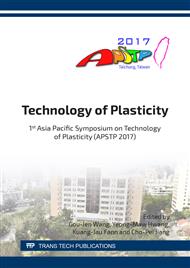p.95
p.102
p.108
p.114
p.120
p.126
p.132
p.141
p.149
Optimizing Design of the Cutting Tool in Cutting of Ultra-High Strength Steel Beam Part
Abstract:
In this research, the cutting process of a martensitic Ultra-High Strength Steel (UHSS) beam is investigated by using finite element method. The Modified Mohr-Coulomb fracture criterion (MMC) is employed in numerical simulation to calculate the ductile fracture during the process evolution. Tensile specimens are designed to obtain various stress states in tension. Equivalent fracture strains are measured with Digital Image Correlation (DIC) equipment to constitute the fracture locus. Based on the simulation, the local load situation of wear serious areas of the cutting tool is studied and the wear reason is explained. Optimizing design scheme for the tool profile is proposed to improve the tool wear. The optimized cutting tool is adopted in the actual industrial production and the wear life cycle is improved up to 14000 times cutting frequency compared with 4000 times cutting frequency for the original tool. The practice results demonstrate that the optimizing design scheme for the tool profile is very successfully.
Info:
Periodical:
Pages:
120-125
Citation:
Online since:
April 2018
Authors:
Price:
Сopyright:
© 2018 Trans Tech Publications Ltd. All Rights Reserved
Share:
Citation:


